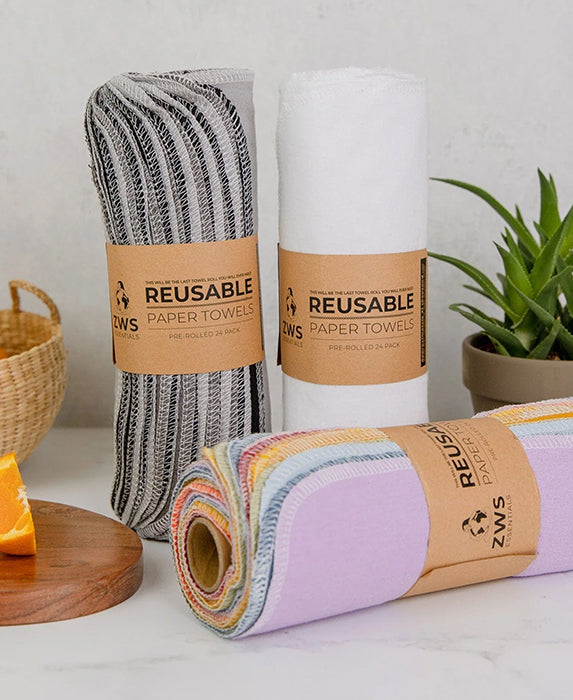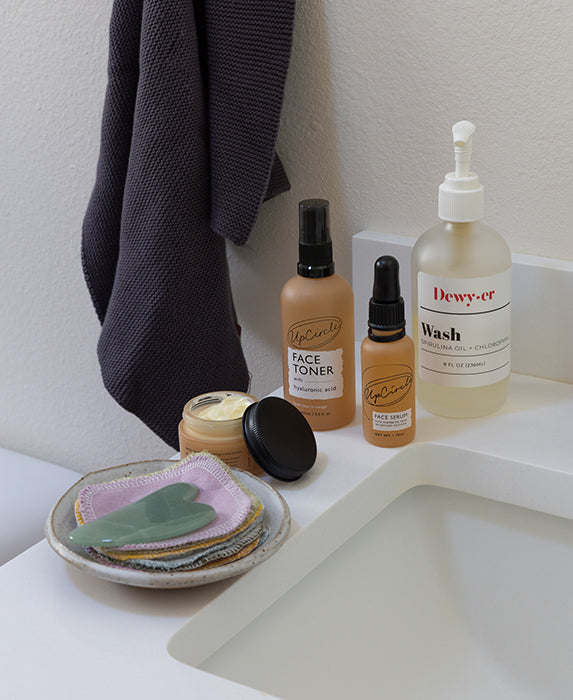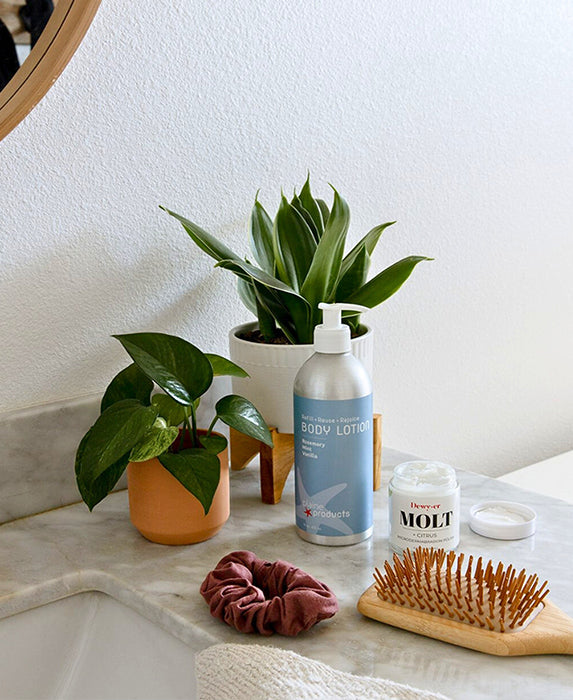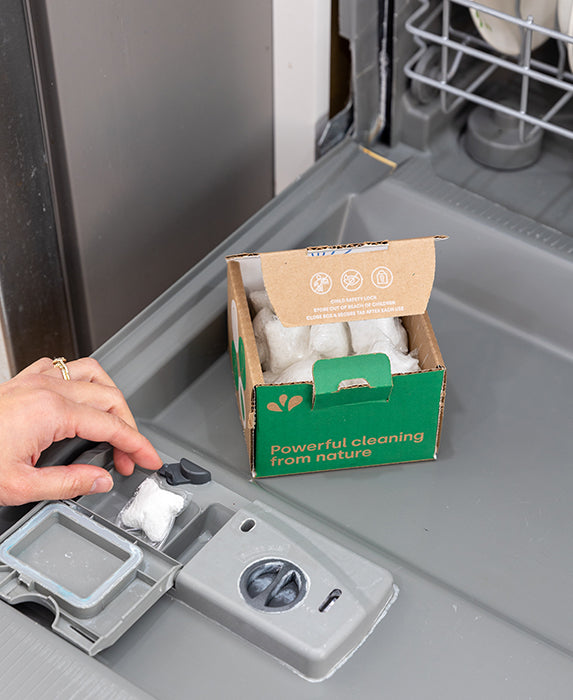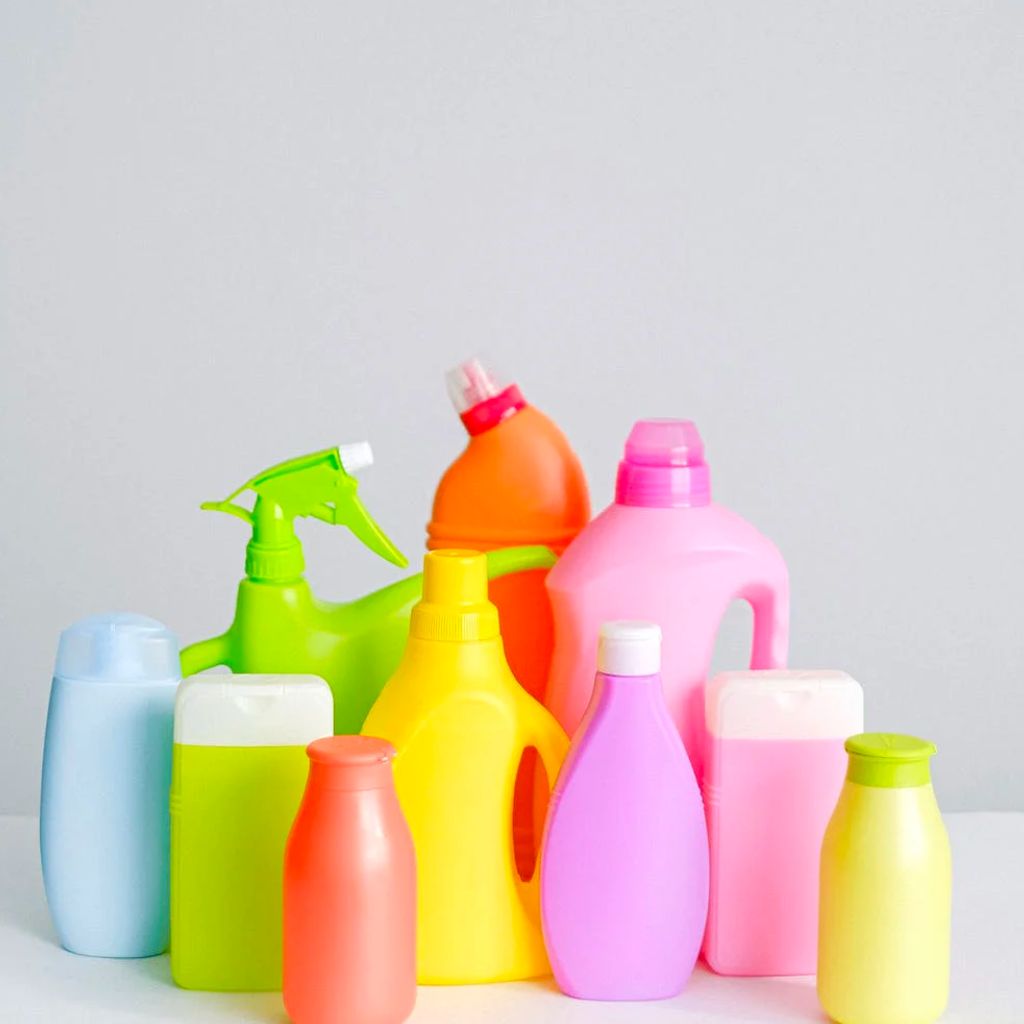Fact: 85% of the toxic chemicals used in personal care, food, packaging, and other everyday products have not been tested–which means we have no idea what impact they can have on our bodies, and our planet. As more and more research on common additives is done, we’re finding out they might be linked to a slew of health problems.
From cancer-causing chemicals, to hormone-disrupting toxins, you’d be shocked to learn what secrets are potentially hiding in your everyday products. While it may feel impossible to completely eliminate your exposure, it’s important to play it safe and be educated about what’s is inside the products you use. Read on to learn about 7 of our least favorite toxins below, and how you can avoid them in your life!
What you’ll learn:
- A breakdown of 7 common toxic chemicals and where they are typically found
- How to avoid them and recognize them in ingredient lists
- How to use EarthHero’s sustainability logos to find safer alternatives
1. Phthalates – The Everywhere Chemical
Phthalates (pronounced Tha-lates) are chemical compounds typically added to plastic products to make them more flexible, durable, and long lasting. These little buggers are in almost everything — plastic food containers, cosmetics, “fresh” produce, electronics, children’s toys and even medical equipment. Simply eating from containers or using skin care products that contain phthalates can expose you to the chemical, and once they are in your body, they are quickly converted into metabolites (tiny molecules) that won’t leave your body for in several days.
Even though phthalates don’t stay in your body long, the impact they can have on your health is significant. One type of phthalate, named Di (2-ethylhexyl) phthalate (DEHP) is a known endocrine disruptor, and researchers are beginning to conduct long-term studies on how this chemical impacts human health. The biggest issue with phthalates, like many toxins, is that we truly don’t know what long-term continuous exposure from multiple sources (think food, skincare, packaging) can impact.
To learn more, the CDC measured 13 common types of phthalates in the urine of 2,636+ participants. What they found was that the general population has measurable levels of many types of phthalates in them–meaning that phthalate exposure is widespread amongst the US population. They also found that, on average, adult women have higher levels of phthalate metabolites than men on average, specifically for the type of phthalates used in cosmetics and personal care products. They also found that, as with like most chemicals, children under the age of 3 are at greater risk when exposed to phthalates–due in part to their smaller body size, and from exposure to phthalates through items products they put in their mouths, like plastic toys, pacifiers, and more.
Phthalates are probably one of the most widely used chemicals in conventional products, and because there is currently minimal regulation when it comes to ingredients, with many companies choose choosing not to label their products as containing phthalates. This feels like seriously scary stuff, but there’s hope! To reduce your exposure, here there are a few things you can do:
- Look for skincare, cosmetics, and other personal care products that is proudly to say “We are phthalate-free!”, and that also disclose their full ingredient lists.
- Use phthalate-free food containers whenever possible (glass, stainless steel)–and never microwave food inside plastic containers that could contain phthalates, as the microwave process will leach those chemicals into your food.
- Look at the ingredients list for these common phthalates: BBP (butyl benzyl phthalate), DBP (di-n-butyl phthalate) *commonly found in nail polish, DEHP (di-2-ethylhexyl phthalate) *often commonly added to PVC products to make them more flexible, DEP (diethyl phthalate) *added to personal care to enhance fragrance, and DiNP (di-isonoyll pthalate) *commonly added to toys and childcare products.
2. Parabens – The Preservative Chemical
These synthetic chemical preservatives are one of the most widely used preservatives in beauty and personal care products today, thanks to the fact that they keep bacteria and mold from growing in your products–extending their shelf life. While this sounds awesome, it actually negatively impacts human health…which is not so awesome.
You can be easily come into contact with parabens by applying them to your skin through makeup, moisturizers, hair care, and shaving cream, as well as by consuming them through preserved foods and food packaging (parabens are even in some pharmaceuticals. Yikes!) A study by the CDC on over 2,500+ participants found methylparaben and propylparaben, two of the most common types of parabens, in most of the people tested–indicating widespread exposure to parabens amongst the American population.
Other researchers have found parabens in breast tumors, linking the toxin to endocrine disruption and potential cumulative health impacts like cancer, as well as finding that butylparaben can severely impact the male reproductive system. Like phthalates, more long-term testing needs to be done to find a definitive relationship between health impacts and parabens, but we personally don’t want to wait to start limiting this chemical in our lives.
Currently, the FDA has no regulations against preservatives like parabens in cosmetics, which means that companies can include these toxins in their products without getting FDA approval–and without having to readily disclose that their products contain parabens. Which means, for now, that it’s up to the individual to protect themselves from such toxins! Here are some tips for doing so…
- Look at the ingredients list for these common parabens: methylparaben, butylparaben, propylparaben, and ethylparaben. More and more companies are proud to say their products are “paraben-free” – be sure to support those ones!
- Avoid food grown with preservatives and opt for organic whenever possible!
3. Sulfates, SLS, & SLES – The Lathering Chemical
Like parabens, these synthetic chemicals are also commonly found in beauty products and traditional household cleaners. They’re known for their ability to create that satisfying lather that elicits the feeling of true (but false) cleanliness! While bubbles are fun and all, absorbing toxins into your body is not. Some of the most common types of sulfate-based chemicals are Sodium Lauryl Sulfate (SLS) and Sodium Laureth Sulfate (SLES), which are what allows your shampoo, soap, and bubble bath to suds up.
These compounds are produced from petroleum and ‘plant’ sources like palm oil, and are created through a chemical reaction with sulfuric acid and other chemicals. In short, they’re derived from not-so-great chemicals, and their production contributes to air pollution, increased greenhouse gases, and ultimately, climate change. But that’s not all…
Studies on sulfates, SLS, and SLES have found that SLS and SLES can irritate the eyes, skin, and lungs–especially with long-term exposure (which happens easily if these chemicals are present in your daily personal care products!). They also found that SLES may contain 1,4-dioxane, which is known to cause cancer in laboratory animals.
Beyond the environmental impacts of production and possible human health issues, simply using products that contain these chemicals can impact our animal biodiversity. The palm oil that is used to manufacture these sulfate-chemicals is a major contributor to tropical rainforest devastation, and then the final formulas are often washed down the drain (think of your shampoo!) where they end up in oceans, lakes, and waterways and can be toxic to different species of animals. All in all, we are not a fan of any version of synthetic sulfates. Check out some ways to avoid them in your life below:
- SLS and SLES are usually found in: liquid soap, shampoo, laundry detergent, dish soap, toothpaste, bath bombs, and other “lathering” personal care items. Opt for solid and oil based soaps and shampoos rather than liquid versions–and keep an eye out for products that are proud to be “sulfate-free”!
- Look at the ingredients list for: sodium lauryl sulfate, sodium laureth sulfate, laureth-8 carboxylic acid, lauryl ether sulfate, and other common synonyms!
4. Oxybenzone – The Sunscreen Chemical
Oxybenzone, aka benzonephenone-3, has been getting a lot of (negative) attention lately–with sunscreen numerous companies saying “we’re proud to be oxybenzone free!” But even so, oxybenzone is still in nearly 80% of conventional sunscreens, with studies from the CDC estimating that oxybenzones are present in more than 96% of the US population. It was initially used because oxybenzone provides UV coverage, while staying colorless, which many sunscreen companies loved for “spray” sunscreens and other innovative products. It’s also used in nail polish, fragrances, hair spray, and some cosmetics.
Despite the fact that oxybenzones are supposed to absorb UV rays and protect us from the sun, studies have shown that oxybenzone is readily absorbed by the skin–where it then stays in our bodies for an unknown amount of time. The EWG has found that oxybenzone, when in our bodies, is highly toxic–and has begun to link the additive to hormone disruption, damaged cells that could lead to skin cancer, and reproductive issues. According to one researcher, Dr. Kurunthachalam Kannan, a professor of public health and environmental health services with the New York State Department of Health, oxybenzone is an even stronger estrogenic than BPA–which has been widely banned due to its toxicity. In fact, oxybenzone even won an award (a bad award…) for being “Allergen of the Year” by the American Contact Dermatitis Society back in 2014.
Beyond that, coral reefs and other ocean ecosystems are highly impacted by the presence of this chemical in our sunscreens–as sunscreens are often rinsed off in the shower, pool, or ocean, where they can end up ingested by sea life, or absorbing into porous coral habitats. Despite all this research, oxybenzone is still FDA approved for use in our products, which means it’s up to us to reduce our exposure with tips and tricks like these…
- Check the ingredients list for these common chemical filters: oxybenzone, avobenzone, octisalate, homosalate, and octinoxate. Instead, look for mineral-based sunscreens that use active ingredients like zinc oxide and/or titanium dioxide.
- Allow your sunscreen to fully absorb into your skin before hopping in the pool or ocean to reduce the amount of run-off that occurs!
- Accept the fact that you may have to rub in your white-based sunscreen a little bit more than your conventional clear sunscreen… or look for mineral-based sunscreens that are slightly tinted! Checkout our blog on natural sunscreens for more info here!
5. Synthetic Dyes – The Colorful Chemical
Fact: the food industry adds more than 15 million pounds of artificial food dyes into our food supply every year–putting them in everything from cereal to soda. They’ve become so prevalent that we often don’t even notice them, or know how to recognize them on the ingredients list. The same is true of synthetic colors in common cosmetics, personal care, and household products, with the FDA enforcing some regulations on what acceptive levels of synthetic colorants are, but not providing the consumer with information on how those additives can impact their health, or the health of the planet.
The truth is, coal, tar, and petroleum are the base for most of the artificial dyes that are used to color anything from clothing to personal care. These dyes contain heavy metals, plasticizers, fluorocarbons, and formaldehyde, and require a great deal of water and energy to produce them. Plus, most artificial colors aren’t readily biodegradable, and end up polluting our waterways and marine ecosystems. On top of that, although they are tested by the FDA, certain synthetic additives are linked to allergic reactions in sensitive individuals. For example, FD&C No. 5 can lead to itching, hives, and other skin reactions, despite the fact that they are considered safe. Some studies from the Center for Science in the Public Interest are even beginning to link these petroleum-based colorants to more serious health risks like cancer, hormone disruption, and hyperactivity (ADD and ADHD).
The good news is that you don’t need synthetic colorants in your products, because natural colorants exist! Things like beet juice powder, red radish powder, annatto powder, and water soluble carmine are all alternatives to synthetic red dyes–and are an awesome way to transform products to have the bold colors we’re so used to seeing.
How to avoid synthetic colors…
- Check the ingredients list of your products for non-FDA-approved synthetic colors like tartrazine. Try not to confuse certified colors with their uncertified counterparts. For example, FD&C Yellow No. 5 is the certified form of tartrazine, and has been FDA certified, but tartrazine has not. You can find a list of FDA approved color additives here.
- Switch from products that use synthetic additives (even if they are FDA approved!) to products that use only natural colorants from plant-based sources.
6. Synthetic Fragrance – The Smelly Chemical
Synthetic fragrances, aka the “new second hand smoke of 2019”, are one of the most prevalent chemical additives–and can be found in countless everyday products including scented candles, detergents, deodorants, air fresheners, shampoos, lotions, and more. Have you ever been around someone with just a little too much cologne on, or walked into a room that has been “Febreez-ed”? While it may seem innocuous, the chemicals that make up synthetic fragrances can be absorbed when we inhale them, and are linked to some serious impacts on our bodies and the planet.
About 95% of the chemicals used in synthetic fragrances are derived from petroleum (crude oil)–which is a finite resource that is extremely unsustainable to harvest, process, and transform into these synthetic chemicals. Beyond their impact on the planet, synthetic scents greatly impact our lungs and respiratory system. One such study shows a decline in exhalation volume by 58% when exposed to synthetic colognes, and is linked to a worsening of asthma symptoms. Additionally, synthetic scents can include those hormone-disrupting phthalates we talked about before, and be linked to health issues like cancer, birth defects, and reproductive issues. These same chemicals
Although fragrances are highly prevalent in our consumer products, it is possible to avoid them in the products you purchase by opting for “fragrance-free”, “unscented” products, alongside certified organic products and those who use essential oils in lieu of synthetic fragrances.
- Swap out synthetic fragrance filled products with those that use natural & organic essential oils to fragrance their products. Avoid ingredients like: benzenes, aldehydes, toluene, styrene, and more.
- Don’t be confused by the word “fragrance”. Fragrance is a catch-all term that can apply to nearly 3,000 various chemicals, all with their own serious impacts!
- Look for unscented or fragrance-free products – but still read the labels carefully to ensure a company is not using some other chemical to masks scents to create the “unscented” experience.
7. BPA – The Water Bottle Chemical
Whether or not you’ve been paying attention to the toxins in your products, BPA has been making major headlines recently for two main reasons: almost everyone has detectable levels of BPA in their bodies, and they can create serious health impacts for fetuses and newborns. But what is BPA? Short for Bisphenonol A, BPA is an industrial chemical used to make polycarbonate–a hard, clear plastic that was used in plastic water bottles, food and product packaging, and as a protective lining in some metal-based items since the 1960s.
According to a study by the CDC back in 2003 on 2,500+ individuals aged 6 years and older, there were detectable levels of BPA in 93% of urine samples–which does not take into account the levels of BPA that may be present in children under the age of 6, the most at-risk demographic. Other studies pursued by the FDA’s National Center for Toxicological Research have continued to analyze the relationship between expectant mothers and BPA, with initial results suggesting long-term health impacts. Beyond that, it is linked to diabetes, heart disease, and endocrine disorders.
In July of 2012, the FDA amended its food additive regulations to ban the use of BPA is baby bottles, sippy cups, and infant formula packaging–but not other places where BPA were readily used. Despite this new regulation, many plastic products still contain BPA–leaving it up to the consumer to avoid it in their lives. But, because of the attention it has gotten, BPA is actually one of the easier toxins to avoid! Checkout some tips and trips to live BPA free below.
- Avoid foods that could be packaged with BPA–like non-organic canned soups, preservative-packed produce, etc.
- Choose cardboard and glass containers over canned goods! Highly acidic foods, like canned tomato sauce, are more likely to leach BPA from the can lining. Opt instead for cardboard and glass containers, instead of cans with plastic linings.
- Do not microwave food from polycarbonate plastic! At high temperatures, these plastics can leach BPA into your food and become easily ingested. Although companies are not required to say if a product has BPA in it, polycarbonate plastics are usually marked with a number #7 recycling code on the bottom.
- Look for baby bottles, toys, and other children’s products that are made by companies who proudly state they are “BPA free!” Because this is the demographic most impacted by the chemical, go the extra mile to research products that are truly BPA free.
BUT DON’T PANIC!
We know…. This is a lot of pretty scary information. And it can feel overwhelming. Toxins seem like they are everywhere–and can seem nearly impossible to avoid. The good news? Companies across the globe are taking matters into their own hands, and banning the toxic chemicals that are linked to negative health impacts… even if the FDA hasn’t.
By embracing the power of natural ingredients on a larger scale, brands are making it easier for their communities to shop products that are chemical-free. On EarthHero, we ensure that no brand or product on our site contains these toxins. Instead, we turn to essential oils, plant-based dyes, and other natural ingredients that work hard–without all the extra gunk added. Checkout our sustainability logos here that we use to label our products that are toxin-free, or look at the “Made Without” Sustainability Feature facet found on each product page!
How do you live a toxin-free lifestyle?
This blog was originally published on April 3, 2019 and was most recently updated on October 27, 2022.


